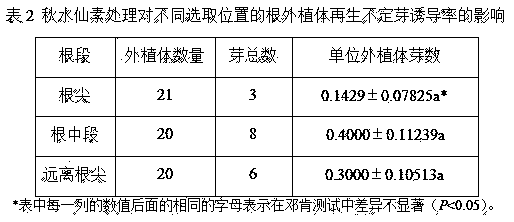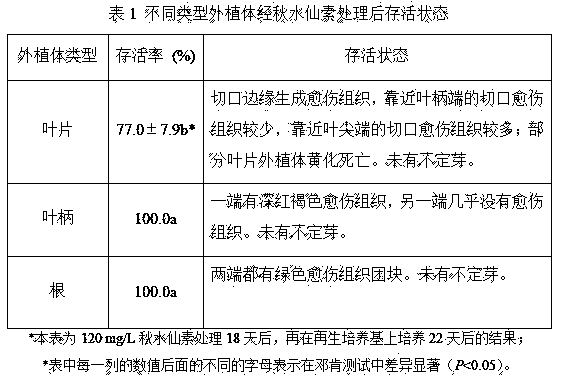Method for improving doubling efficiency for inducing triploid echinacea chromosome by colchicine
A chromosome doubling and colchicine technology is applied in the fields of crop biotechnology and genetic breeding, which can solve the problems of low success rate of polyploid induction and achieve the effect of overcoming the poor doubling effect.
- Summary
- Abstract
- Description
- Claims
- Application Information
AI Technical Summary
Problems solved by technology
Method used
Image
Examples
Embodiment 1
[0025] Example 1 The Effect of Colchicine on the Survival Status of Different Types of Explants
[0026] The diploid seeds of Echinacea purpurea used in the present invention are purchased from the Plantation Products horticultural company of Norton, Massachusetts, U.S.; Tetraploid carries out colchicine treatment to diploid Echinacea purpurea through applicant's existing method and its chromosome doubling is obtained (Nilanthi, 2009); triploids were obtained by crossing diploids and tetraploids and cultivating seeds.
[0027] For the obtained triploid Echinacea purpurea, the leaves, petioles and root explants were respectively treated in the medium containing 120 mg / L colchicine for 18 days, and then transferred to the medium containing BA 0.4 mg / L, NAA 0.01 mg / L, They were cultured on MS regeneration medium with 30 g / L sucrose and 4.5 g / L agar, and the survival rate of explants was counted after 22 days. It can be seen from Table 1 that the culture responses of different ...
Embodiment 2
[0029] Example 2 The effect of root explant selection position on induction of adventitious buds after colchicine treatment
[0030] For the same triploid line, after 30 days of rooting, select roots with similar states, and intercept different positions (near the root tip, middle, and far from the root tip). BA 0.4 mg / L, NAA 0.01 mg / L, sucrose 30 g / L, agar 4.5 g / L MS medium, at 23-27°C, cool white light intensity 600-1300 lx, photoperiod 12 h / d After culturing for 25 days under the same conditions, the adventitious buds were induced to regenerate on MS medium containing 0.5 mg / L BA, and the induction rate of adventitious buds was studied. According to Table 2, as long as the roots are rooted at the same time, and the selected roots are close to each other, no matter whether the root section close to the root tip is used as the explant or the root section far away from the root tip is used as the explant, the After the doubling of narcissine, there was no significant differ...
Embodiment 3
[0032] Example 3 Effects of Different Concentrations of BA on Inducing Adventitious Buds After Colchicine Treatment
[0033] Triploid root explants treated with colchicine at a concentration of 120 mg / L for 25 days were inoculated on MS medium containing different concentrations of BA (0.3, 0.7, 1.4 mg / L). ~1300 lx, 12-h photoperiod environment, after 45 days of culture, observe and count the number of regenerated shoots on the unit explant. According to Table 3, the explants treated with colchicine had the highest proportion of regenerated shoots at 0.7 mg / L BA, with an average of 0.38 adventitious shoots per explant. No regeneration of adventitious shoots occurred when the concentration of BA was 0.3 mg / L.
[0034]
PUM
 Login to View More
Login to View More Abstract
Description
Claims
Application Information
 Login to View More
Login to View More - R&D
- Intellectual Property
- Life Sciences
- Materials
- Tech Scout
- Unparalleled Data Quality
- Higher Quality Content
- 60% Fewer Hallucinations
Browse by: Latest US Patents, China's latest patents, Technical Efficacy Thesaurus, Application Domain, Technology Topic, Popular Technical Reports.
© 2025 PatSnap. All rights reserved.Legal|Privacy policy|Modern Slavery Act Transparency Statement|Sitemap|About US| Contact US: help@patsnap.com



